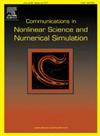正则化Prabhakar和[公式省略]-Hilfer分数阶导数下二维时间分数阶非线性生物种群模型的精确可分离解
IF 3.8
2区 数学
Q1 MATHEMATICS, APPLIED
Communications in Nonlinear Science and Numerical Simulation
Pub Date : 2025-07-18
DOI:10.1016/j.cnsns.2025.109145
引用次数: 0
摘要
本文的主要目的是研究在两种不同的分数阶导数定义下,即正则化Prabhakar和ψ-Hilfer分数阶导数,如何用不变子空间方法计算包含两个空间变量和一次性变量的二维非线性偏微分方程的分数阶时间导数的精确可分解。我们还明确地证明了不变子空间方法在计算生物种群模型的二维分数阶时间导数的精确可分离解中的重要性和实用性,这有助于更准确地预测种群将如何增长或缩小。更具体地说,我们系统地展示了如何利用不变子空间方法计算上述模型的线性空间。在此基础上,利用计算得到的不变线性空间,研究了上述两种不同时间分数阶导数下线性和非线性生物种群模型的精确可分解的计算。此外,我们注意到所考虑的方程在ψ-Hilfer分数阶导数下的计算解在ψ-Riemann-Liouville, ψ-Caputo, Hilfer, Katugampola, Caputo-Katugampola, Riemann-Liouville和Caputo分数阶导数下是有效的,因为ψ-Hilfer分数阶导数是这些分数阶导数的推广。另外,请注意,在两个分数阶导数下,计算出的基本方程的精确可分离解是用三角函数、指数函数和多项式函数表示的,这些函数带有两个或三个mittagg - leffler函数参数。此外,还将得到的不同分数阶导数下的解与二维图形表示进行了比较。最后,给出了该模型在各种分数阶导数下的初值和边值问题的精确可分解,并对它们进行了比较。本文章由计算机程序翻译,如有差异,请以英文原文为准。
Exact separable solutions of two-dimensional time-fractional nonlinear biological population model under the regularized Prabhakar and ψ-Hilfer fractional-order derivatives
The main aim of this work is to investigate how to compute the exact separable solutions using the invariant subspace method for the fractional-order time derivative of two-dimensional nonlinear partial differential equations involving two space and one-time variables under two different fractional-order derivative definitions, namely the regularized Prabhakar and -Hilfer fractional-order derivatives. We also explicitly demonstrate the importance and usefulness of the method of the invariant subspace approach in computing the exact separable solutions for the two-dimensional fractional-order time derivative of the biological population model, which helps more accurately predict how populations will grow or shrink. More specifically, we show systematically how to compute the linear spaces for the above-mentioned model with the help of the invariant subspace approach. Furthermore, the computations of exact separable solutions are investigated for the linear and nonlinear biological population models under the above-mentioned two different time fractional-order derivatives with the help of the computed invariant linear spaces. Additionally, we notice that the computed solutions of the considered equations under the -Hilfer fractional derivative are valid under the -Riemann–Liouville, -Caputo, Hilfer, Katugampola, Caputo–Katugampola, Riemann–Liouville, and Caputo fractional derivatives because the -Hilfer fractional derivative is a generalization of those fractional derivatives. Also, note that the computed exact separable solutions to the underlying equation under two fractional-order derivatives are expressed in terms of trigonometric, exponential, and polynomial functions with two or three parameters of Mittag-Leffler functions. In addition, the obtained solutions under different fractional-order derivatives are compared with two-dimensional (2D) graphical representations. Finally, the exact separable solutions are presented for the initial and boundary value problems (IBVPs) of the discussed model under various fractional-order derivatives and their comparison.
求助全文
通过发布文献求助,成功后即可免费获取论文全文。
去求助
来源期刊

Communications in Nonlinear Science and Numerical Simulation
MATHEMATICS, APPLIED-MATHEMATICS, INTERDISCIPLINARY APPLICATIONS
CiteScore
6.80
自引率
7.70%
发文量
378
审稿时长
78 days
期刊介绍:
The journal publishes original research findings on experimental observation, mathematical modeling, theoretical analysis and numerical simulation, for more accurate description, better prediction or novel application, of nonlinear phenomena in science and engineering. It offers a venue for researchers to make rapid exchange of ideas and techniques in nonlinear science and complexity.
The submission of manuscripts with cross-disciplinary approaches in nonlinear science and complexity is particularly encouraged.
Topics of interest:
Nonlinear differential or delay equations, Lie group analysis and asymptotic methods, Discontinuous systems, Fractals, Fractional calculus and dynamics, Nonlinear effects in quantum mechanics, Nonlinear stochastic processes, Experimental nonlinear science, Time-series and signal analysis, Computational methods and simulations in nonlinear science and engineering, Control of dynamical systems, Synchronization, Lyapunov analysis, High-dimensional chaos and turbulence, Chaos in Hamiltonian systems, Integrable systems and solitons, Collective behavior in many-body systems, Biological physics and networks, Nonlinear mechanical systems, Complex systems and complexity.
No length limitation for contributions is set, but only concisely written manuscripts are published. Brief papers are published on the basis of Rapid Communications. Discussions of previously published papers are welcome.
 求助内容:
求助内容: 应助结果提醒方式:
应助结果提醒方式:


